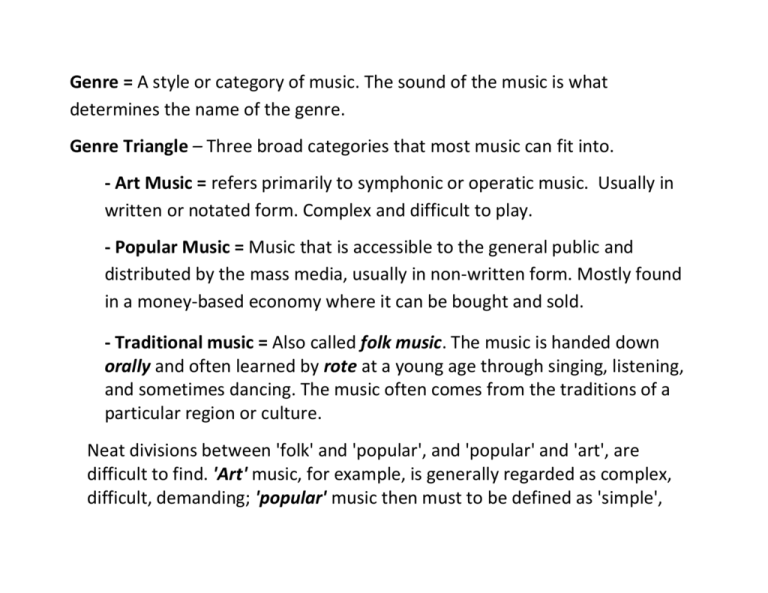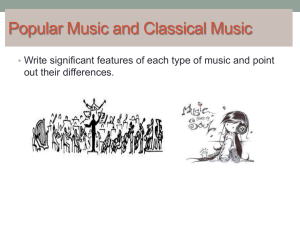Art Music Genres
advertisement

Genre = A style or category of music. The sound of the music is what determines the name of the genre. Genre Triangle – Three broad categories that most music can fit into. - Art Music = refers primarily to symphonic or operatic music. Usually in written or notated form. Complex and difficult to play. - Popular Music = Music that is accessible to the general public and distributed by the mass media, usually in non-written form. Mostly found in a money-based economy where it can be bought and sold. - Traditional music = Also called folk music. The music is handed down orally and often learned by rote at a young age through singing, listening, and sometimes dancing. The music often comes from the traditions of a particular region or culture. Neat divisions between 'folk' and 'popular', and 'popular' and 'art', are difficult to find. 'Art' music, for example, is generally regarded as complex, difficult, demanding; 'popular' music then must to be defined as 'simple', 'accessible', and 'easy'. But many pieces commonly thought of as 'art' (Handel's 'Hallelujah Chorus', many Schubert songs, many Verdi arias) have qualities of simplicity; on the other hand, it is by no means obvious that many punk rock records were 'accessible', Rush’s work 'simple', or Whitney Houston’s singing 'easy'. Musical technique is the ability of instrumental and vocal musicians to display extreme mastery of their instrument of choice. It takes many years to achieve true mastery at anything. Musicians are no exception to this. Repetition and practice is the key. “Practice or perform any skill 10,000 times, and you are surely on the road to mastery of that skill”. Art Music Genres: Medieval Styles 450 - 1450 Gregorian Chant Motet Organum Estampie Renaissance Styles 1450 - 1600 Ballade Chanson Carol Madrigal Mass Opera Toccata Baroque Styles 1600 - 1750 Cantata Concerto Fugue Mass Minuet Motet Opera Buffa Opera Seria Oratorio Prelude Sinfonia Sonata Classical and Romantic Styles 1750 - 1900 Ballet Carol Concerto (Flute concerto, piano concerto… etc.) Etude Lied Mass March Opera (many subgenres of opera!) Oratorio Quartet Quintet Requiem Rhapsody Scherzo Serenade Sonata (Piano sonata, flute sonata… etc.) Symphony Waltz Popular Music Genres Avant-Garde – Music that is thought to be ahead of its time that fuses many genres, sounds, and influences. Unique, original, and unexplored sounds and musical styles fall under this category. Blues – Originated in the “Deep South” of the United States around the end of the 19th Century from spirituals, work songs, field hollers, and chants. The blues were sung mostly by slaves and African American performers. Comedy Music – Music that is humorous or funny in nature. This genre encompasses a wide variety of musical genres. Novelty songs, comedic rock, comedic hip-hop, and parodies fall under this category. Country – Originated in farm communities and the rural South around the 1920s. Used to be called hillbilly music and is generally made up of simple harmonies, melodies, and forms. It is usually accompanied by string instruments such as banjo, electric and acoustic guitars, and fiddles. Harmonica is also common. Sub-genres include: Americana, Bluegrass, Country-pop, Dixieland, Cowboy/Western and many many others. Easy Listening – Originated around the 1950s out of big band music. It is often called MOR (middle-of-the-road), Lounge music, Adult Contemporary, Elevator music, or Beautiful music. This genre also features vocalists such as Frank Sinatra, Nat King Cole, Barbara Streisand among many others. These singers preferred to sing songs written by other people from a bygone era often called pop standards. Electronic - Very large genre of music that uses electronic musical instruments and electronic music technology in its creation. This can include electric guitars, synthesizers, and other instruments actually played, but most recently has been composed mostly on computer. Sub-genres (hundreds of these exist!!) include: Ambient, Breakbeat, Disco, Downtempo, Drum and Bass, Dub, Dubstep, Electro, Electronica, House, Industrial, Techno, and Trance. Modern Folk - Originated from traditional folk music and had its largest popularity in the 1960s. It is usually accompanied by acoustic guitar and is very mellow and soothing in tone. Lyrics tend to be very emotional and/or story-telling in nature. Melodies are simple and harmonies are two-part or three-part. Many sub-genres exist! Hip-Hop – Often called rap, this music is accompanies stylized rhythm and usually, if not always, includes rapping or chanting. It developed as part of a hip-hop culture with four key elements: MCing(mic controlling)/rapping, DJing(disc-jockeying)/scratching, breakdancing, and graffiti writing. The music in hip-hop is most often sampled. This is when a small portion of a song is reused in a new form or context and a new melody is often written to accompany it, and verses are rapped. Most forms of hip-hop include vulgar or profane lyrics (bad words). Some of the many sub-genres are: Conscious Rap, Crunk, East Coast, Freestyle Rap, G-Funk, Gangsta Rap, Hardcore Rap, New Jack Swing, Reggaeton, Rap Rock, Southern Rap, and Trip Hop. Jazz – A form of art music which originated in the United States through the confrontation of African blue notes and rhythms, American popular music, and European music history. Special rhythm called swing is often used as well as incorporating improvisation much of the time. Many sub-genres exist! Some are: Ragtime, Swing, New Orleans Jazz, Bebop, Afro-Cuban, Cool Jazz, Jazz Fusion, and Jazz Funk. Latin American – A style of music encompassing rhythms, instrumentation, and styles associated with Latin America, but mixed with European and American styles. Many sub-genres exist! Some are: Salsa, Mambo, Samba, Merengue, Mariachi, and Tango. Pop – A style borrowing elements from many other genres including urban, dance, rock, Latin, and country that has short to medium length songs written in a basic verse-chorus format with repeated choruses, melodic tunes, and very catchy and memorable hooks/choruses. Pop music is very pleasurable to listen to rather than having much artistic depth and is known for having mass appeal. Countless sub-genres exist! R&B – Rhythm and blues. Starting in the 1940s, the term R&B originated as a record company descriptor of music marketed to African-American people. R&B is an urban, rocking, and often jazzy form of music with an insistent beat. Many sub-genres exist! Some are: Boogie, Blue-Eyed Soul, Disco, Doo-Wop, Funk, Motown, New Jack Swing, and Soul Music. Rock – Originated from rhythm and blues and country music in the 1950s and 1960s. Often called Rock and Roll, it is an upbeat, mostly electric guitar and sometimes piano driven music with a strong beat. It is usually in 4/4 time, with a verse-chorus format. Thousands of sub-genres exist! Some examples are: Alternative (with thousands of its own sub-genres!), Grunge, Folk Rock, Glam Metal, Heavy Metal, Hard Rock, Pop Rock, New-Wave, Progressive Rock, and many others. Ska – This type of music originated in Jamaica in the 1960s and came before dancehall and reggae music. It is characterized by its rhythms which fall on the upbeat and its walking bass lines. Ska combines elements of calypso, Carribean, American Jazz, and rhythm and blues. There were 3 waves of ska: The original, Jamaican, or 1st wave from the 1960s; the 2-tone or 2nd wave that happened in Europe in the late 1970s; and the 3rd wave that happened in the United States in the late 1980s and 1990s. Some sub-genres include: 2-Tone, Dancehall, Dub, Reggae, and Rocksteady.




